In Part 1 of my PCT gear reviews, I went over the Big Three. Now, I’ll move on to my cooking, clothing, and hygiene systems.
Cooking
Some people go on a no-cook diet while thru hiking to save on time cooking and hassle of finding fuel. I don’t know what I’d eat for dinner if I didn’t cook, and I usually enjoy the hot meal, so I cooked the whole trail. There were some nights that I didn’t cook out of lack of water or exhaustion, but I would just switch that night’s dinner for the next day’s lunch, or not eat at all (always a mistake, but sometimes I was very tired).
I loved the alcohol stove I used on the Appalachian Trail and have been using it ever since, but alcohol stoves were banned most of this year on the PCT. Because of the drought, and later because of wild fires, any stove that did not have an on/off switch was not allowed. I used my canister fuel stove, an older model of the Brunton Optimus Crux. There are a few lighter canister stoves, but not enough lighter to make it worth buying a new one, and this one worked just fine the whole time.
I used my trusty Evernew Titanium .9L Pot to cook in, with the handles removed. It can fit a whole Pasta Sides meal easily, or just barely fit a whole regular sized box of mac and cheese. I would pour my meal in, cover it with water, and put it on the stove until it started boiling. Then I would turn the stove off, transfer it to my AntiGravityGear Pot Cozy with my MSR LiteLifter, where it would continue to cook for ten or so minutes while I generally finished setting up camp. Then I’d eat dinner with my MSR Folding Spork. Pot, cozy, lifter, and spork have been through the AT and more, and now the whole PCT too. A lot of people lose sporks right and left, but I pack the whole system in the pot cozy and haven’t lost anything. I also carried a Mini BIC lighter and a bandana to round out the system.
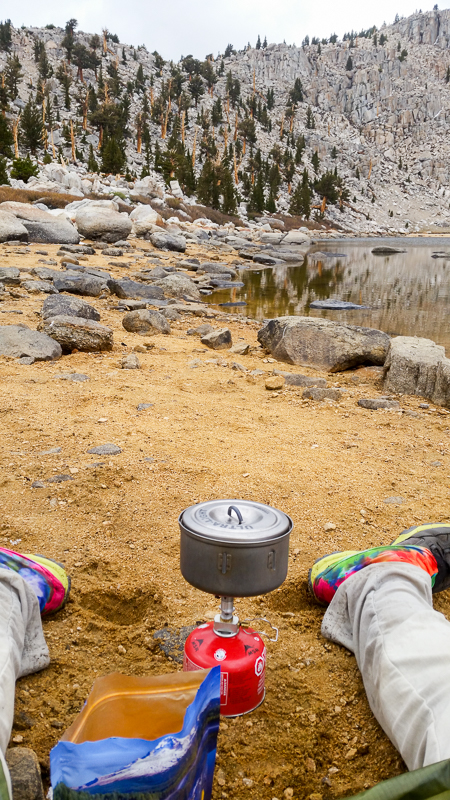
Cooking in the Sierra
One thing I worried about with using canister fuel was that I would run out of fuel quickly and then not be able to find a new can. Using the pot cozy though, I barely used any fuel per meal, and the smallest can would last around a month or more. The cans generally weren’t hard to find in town, but my guidebook would tell me if they’d be scarce coming up and I’d grab an extra if my current can was low.
Food Storage
My food storage container changed a few times. I started out with my normal Sea to Summit 20L Ultra-Sil Dry Sack. In the Sierra, I was required by National Park regulations to carry a bear can, so I picked up a BV500. It fit in my pack in place of my food bag, but all of my food did not fit in the can, and I kept the food bag tied to the top of my pack with my extra food in it. I would say I could fit four days of thru hiker diet in the bear can, but I was still pretty hungry. You’re probably not supposed to have food outside of the bear can according to regulations, but it was way more than four days between resupplies there, and I certainly wasn’t going to carry two bear cans. I did get stopped by a ranger in Yosemite to check for my permit and bear can, but he either didn’t notice, or chose to ignore, the food bag.
After the Sierra, I went back to my food bag. That bear can was bulky and annoying. A little while later, I met the wife of the creator of the Ursack in a grocery store parking lot, and she said to email him when I was entering Washington. I did, and got a discount on the bear bag! Since I had to take off time due to injury, I got ahead of my friends and I skipped Oregon to do later. I figured I might be camping alone a lot more frequently and it wouldn’t hurt to take bear precautions. It turned out I did have hiking partners for most of the rest of the trip, but I still used the Ursack. However, I used it with an Opsak, basically a giant ziploc bag that blocks odors. I had used one previously on the AT and my stuff never got bothered, even sitting on the floor of a shelter where many mice lived. Nothing bothered me this time either.
Water
For water containers, I carried a Platypus 3L Hoser and two Platypus 1L SoftBottles. The bottles had already made it through almost 3,000 miles of hiking and were starting to crack some, so I eventually replaced them with 1L Smart Water bottles. In the desert, I sometimes added more Smart Water bottles, depending on how long the dry stretches of trail would be. I kept one bottle clean for drink mixes, so I didn’t have that coming through my bladder hose (harder to clean), and used one bottle to collect dirty water, which I would then filter through my Sawyer Squeeze Filter. I actually started out with the Sawyer MINI, but the flow was so incredibly slow. Switching to the regular size added maybe an ounce in weight and it was absolutely worth the time savings. I didn’t back flush the filter a whole lot, maybe every other town, but the flow stayed good for the approximately 1,800 miles I used it.
I followed the instructions in this video to set up my bladder so that I could filter right into the hose without having to take the bladder out of my pack. I used the Sawyer Inline Hydration Pack Adaptor and 1.5 sets of Camelbak Quick Link Conversion Kits. It looks like Sawyer now makes a Fast Fill Hydration Pack Adaptor that would replace the previous two items.
Clothing
I started the trail with the shirt that I would wear the entire time: a Columbia men’s long sleeve sun shirt. It did a great job of protecting me from the sun and I had the extreme tan lines to prove it. I had to go with a men’s shirt for length, as most women’s shirts are not long enough for me. For more sun protection, I had the Outdoor Research Sun Runner Cap and the Outdoor Research Spectrum Sun Gloves. They were invaluable not only in the desert, but also in the high altitude of the Sierra. Despite the dorky look of a hat with a cape and gloves, it was totally worth it. Plus, there were no mirrors, so I didn’t have to look at me. That sun is brutal.
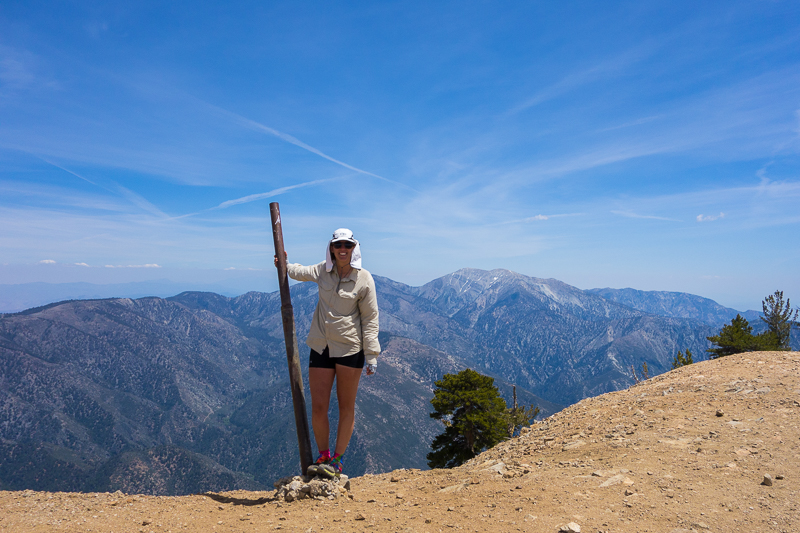
Starting outfit including shorts #1
I switched my pants up several times over the trip. I started with some simple spandex Under Armour shorts but didn’t like them very much. The legs rode up all the time, and I had some chafing where the seams of the legs met on my thighs. I had to use sunscreen until I got a base tan, but it didn’t take long. Right before the Sierra, I got my Columbia Women’s Explorer Convertible Pants (no longer available but they did come in tall sizes!) sent to me, thinking pants would be better all around protection at high altitude. They were way too hot though, and my friends started calling me Lady in Beige and Safari Siren. They also didn’t stretch very well around my thighs, and kept dropping down because the waist was a little too big, so they just annoyed me. I had my shorts from the AT sent out, simple mesh Nike shorts with a wide, flat waistband that sits very comfortably under my pack’s hipbelt. I love those shorts. Later, as it got cold towards the top of Washington, I picked up some Lucy Get Going Capris and was happy to have the extra leg covering.
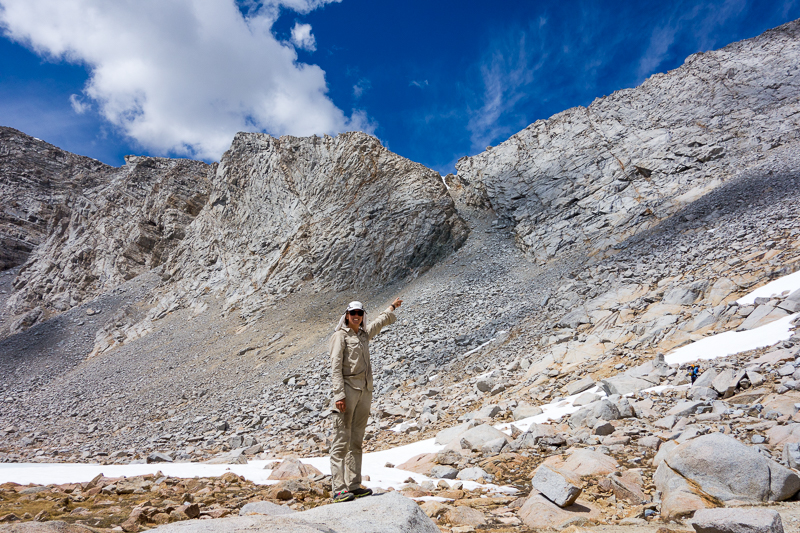
Outfit #2, AKA “Lady in Beige”
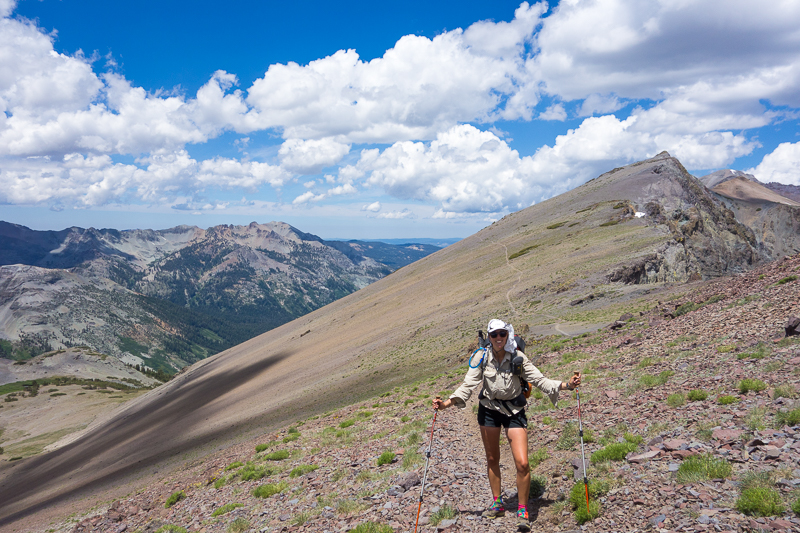
Outfit #3, including shorts #2
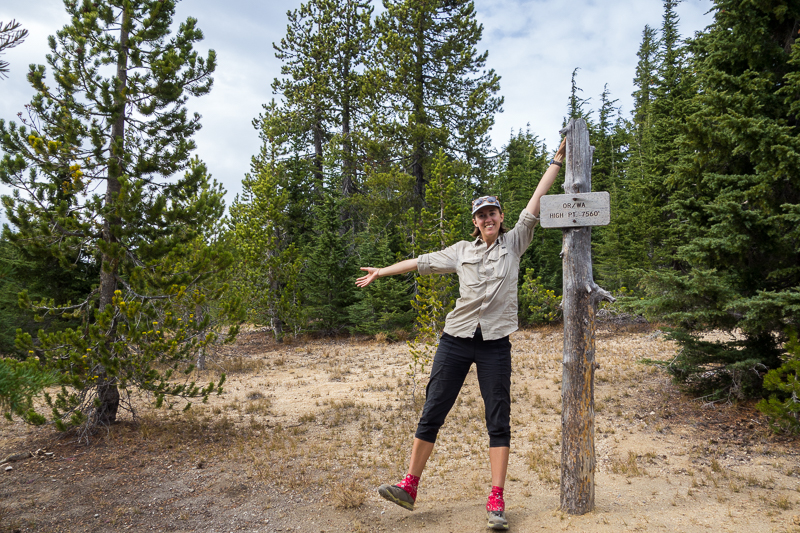
Outfit #4, featuring capris
For underwear, I had two pairs of Patagonia Active Briefs, one EMS Seamless Cami Bra, and one Patagonia Barely Bra. I liked all of them. The bras are a little stretched out, but the Patagonia one also went through the AT. I had two pairs of Darn Tough Hiker 1/4 Sock Cushion Socks, and switched them out for new pairs about half way through. They were starting to not be able to be cleaned very well but I’ll fix them up now that I’m home.
I carried an outfit specifically for sleeping in order to help keep my sleeping bag clean. I used a Moving Comfort Flex 1/2 Zip Shirt, an older version of the Smartwool Midweight Long Underwear bottoms, and Darn Tough Light Hiker Micro Crew Light Cushion socks. I had actually started with some REI Silk Long Underwear Bottoms, but they were not warm enough, and I quickly had the wool ones sent out.
For warmth, I wore a Marmot Quasar Jacket, a Melanzana Micro Grid Beanie, a Buff, and starting in the Sierra, I carried a pair of Outdoor Research PL 100 Sensor Gloves. I carried a The North Face 100 weight long sleeve fleece briefly in the Sierra, but it wasn’t really necessary. I also picked up an REI Revelcloud Vest in northern Washington so I could have another warm layer to hike in. I don’t hike in my sleep shirt or down jacket, in an effort to keep those clean and dry.
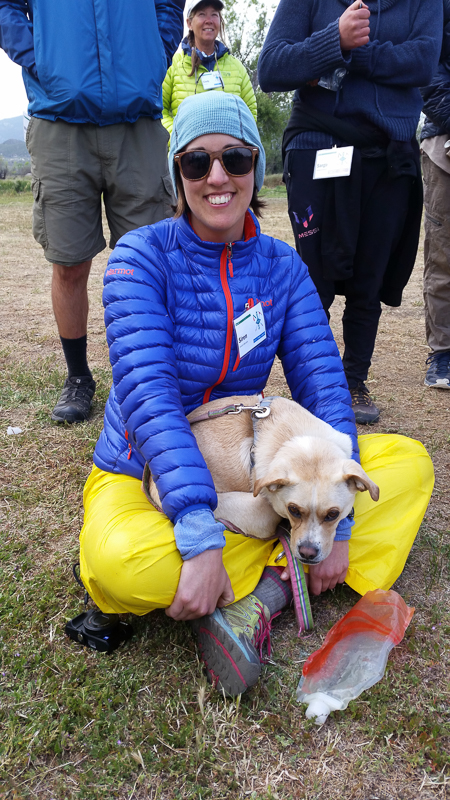
Down jacket, fleece hat, rain pants #1
I switched up my rain gear a few times, starting with a Frogg Toggs DriDucks UltraLite rain suit. I figured it wouldn’t rain much in the desert so I’d save weight and money by starting with these. The bright yellow color led to my nickname of Captain Siren since I looked like I should be on a boat somewhere. When I switched my shorts to pants, I decided to get rid of the rain pants from this set and get my LightHeart Gear Rain Wrap skirt. Then the DriDucks jacket started leaking so I got my Marmot Essence Jacket sent out. As it got colder, I decided I needed rain pants again, and I got my REI Ultra Light Rain Pants sent. Then I switched my jacket one more time because I had the opportunity to test an Ultimate Direction Ultra Jacket. The UD jacket worked fine up to a point, but it’d still wet through after all day rain. The Marmot jacket and REI pants were the best performing of the lot.
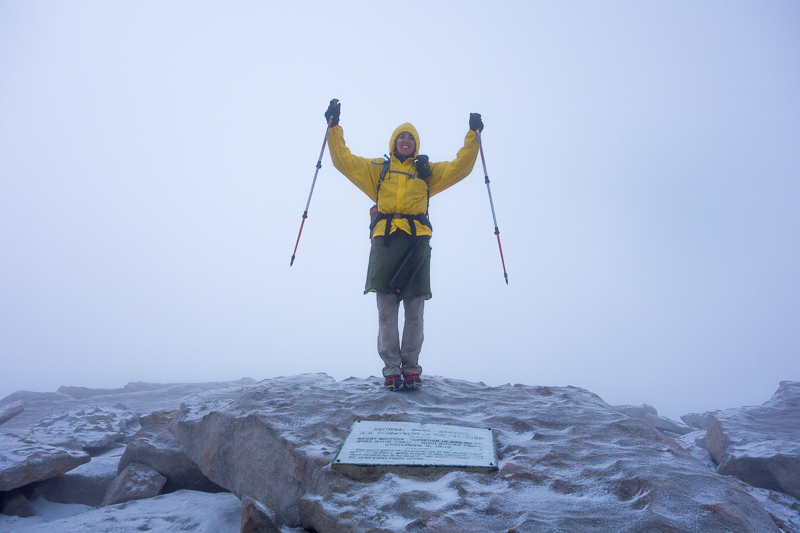
Rain jacket #1, rain skirt
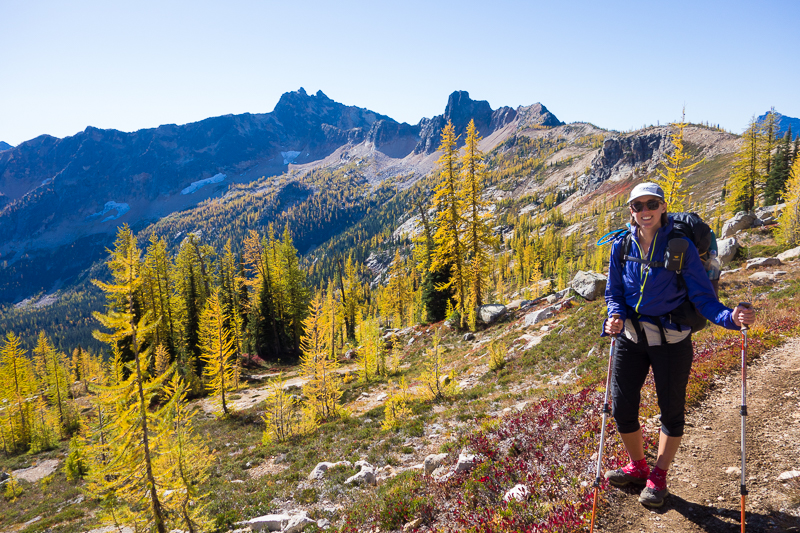
Rain jacket #3
On my feet, I wore Vasque Inhaler Low shoes, which were amazing. The Vibram sole lasted forever, and I’d get at least 1,000 miles on them before the midsole cushioning broke down. I was a couple hundred miles into my third pair at the end of the trail. I enhanced the shoes with Superfeet Berry insoles, and I topped them off with Dirty Girl Gaiters to keep crap out of my shoes.
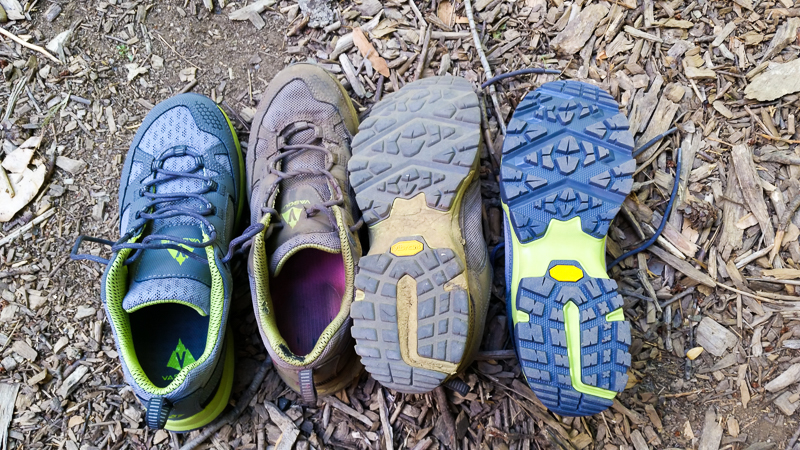
New shoes at 1,100 miles

New insoles at 1,100 miles
I also wore a Timex Expedition watch, some freebie plastic sunglasses, and carried an extra bandana. Whatever I wasn’t wearing went into a Sea to Summit 13L Ultra-Sil Dry Sack in my pack.
Hygiene
My hygiene consisted of two ziploc bags. One held toilet paper and a small container of hand sanitizer, which went along with the MSR Blizzard Tent Stake I carried for use as a trowel. The other bag held a travel toothbrush, travel toothpaste, small comb, nail clippers, travel sunscreen, a 1oz plastic container of Bag Balm, and a small amount of floss. Sometimes there would be other items in there like vitamins or wet wipes or Nivea cream, but everything always fit in a 1 quart ziploc.
Stay tuned for Part 3. In the meantime, see my complete PCT gear list here.

Leave a Reply